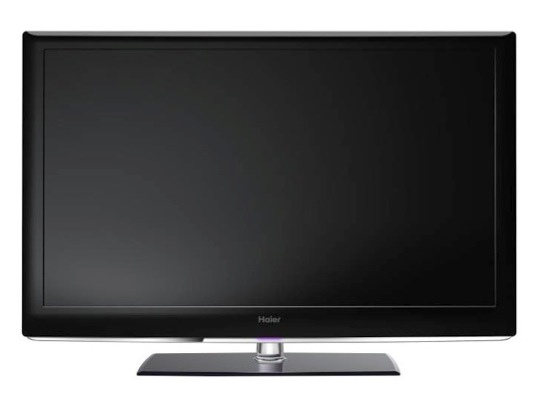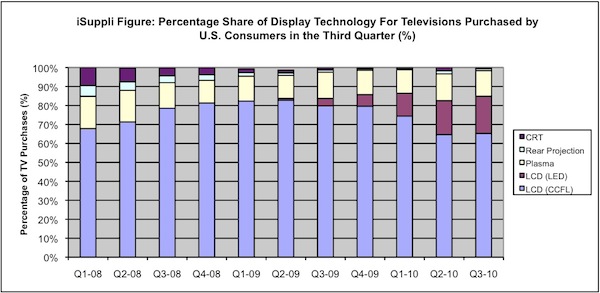 iSuppli announced that one out of every five Liquid Crystal Display televisions (LCD TV) sold in the United States during the third quarter of 2010 used Light Emitting Diode (LED) backlighting.
iSuppli announced that one out of every five Liquid Crystal Display televisions (LCD TV) sold in the United States during the third quarter of 2010 used Light Emitting Diode (LED) backlighting.
For more information visit: www.isuppli.com
Unedited press release follows:
LED Backlights Used in 20 Percent of LCD TVs Sold in US During Q3
El Segundo, Calif., December 17, 2010 — One out of every five liquid-crystal display televisions (LCD TV) sold in the United States during the third quarter used light-emitting diode (LED) backlighting, a dramatic increase from the same period in 2009, as availability of sets equipped with the technology soared, according to the market research firm iSuppli, now part of IHS Inc. (NYSE: IHS).
LED-backlit LCD TVs accounted for 19.6 percent of TV purchases in the third quarter, up from 17.9 percent the previous quarter and from 4 percent during the third quarter of 2009, an iSuppli survey of U.S. consumers has revealed.
“On the demand side, consumers are attracted to LED-backlit LCD TVs by attributes including their thinner form factors, improved picture quality, better color saturation, power savings and other green attributes,” said Riddhi Patel, director and principal analyst for television systems at iSuppli. “On the supply side, television and panel makers are investing in technology and offering a plethora of products to take advantage of LED-backlit LCD TVs, including product differentiation, innovation, low power consumption and the potential to reap the benefits of higher revenue.”
The majority of U.S. consumers in the third quarter continued to buy older non-LED-type LCD TVs—also known as cold cathode fluorescent lamp (CCFL)-backlit sets. The share of the overall U.S. television market for CCFL LCDs rose to 65.3 percent, up from 64.6 percent in the second quarter, with the increase coming at the expense of other display technologies, including plasma, rear projection and cathode ray tube.
The 1.7 percentage point expansion in the share of LED-backlit LCD TVs was more than double the rate of increase seen for CCFL-type LCD TVs, iSuppli data show.
For the other technologies, plasma purchases accounted for 13.5 percent of the U.S. television market in the third quarter, down from 14.2 percent during the second quarter. Both rear-projection TVs and tube-type cathode ray tube (CRT) televisions continued on a trajectory of irreversible decline, down to 0.9 percent and 0.7 percent, respectively.
The attached figure presents iSuppli’s data on U.S. TV consumer purchases from the first quarter of 2009 to the third quarter of 2010.
Consumer interest was also on the rise for Internet-enabled television (IETV). In the third quarter, among consumers who said they connected their televisions to the Internet, almost 50 percent bought sets with the option for built-in Internet connectivity, compared to those who accessed the Internet through other means, such as a game console, an Internet-enabled Blu-ray player, a PC or laptop, or a digital video box.
Among the key applications for IETV, the most popular were YouTube, for watching personal videos; and Netflix, with its Instant Watch feature that allows direct streaming of movie and video content.
The favorite LCD TV size was in the 40- to 49-inch range, accounting for 44.8 percent of all purchases during the period. The 32-inch continued to be popular for use in secondary bedrooms, evident in the 23.2 percent share of consumers buying TVs in the 30- to 39-inch sizes. Among those who bought plasma televisions, the 42-inch was the preferred size.
The share of 3-D TVs among overall purchases was negligible, barely registering a blip. Nonetheless, of the 3-D TVs that were purchased, most were bought in the 50-inch-and-larger sizes by higher-income groups.
“Picture quality was rated as the most important criterion when buying a television, trumping even the presence of advanced technologies like LED backlights or Internet connectivity,” Patel said. “Next to picture quality, price and screen size followed in significance. On the other hand, brand name is losing its once-powerful allure and is now less influential in the decision-making process, because front-of-screen performance among different brands in store environments is perceived to be similar by consumers. Consumers today buy what they believe to offer the best picture quality, and brands able to demonstrate superior front-of-screen performance in stores tended to win over the customer.”
Among brands, Vizio dominated at Walmart and club stores across the country, while Samsung led in other retail areas.
The results of the quarter are taken from iSuppli’s U.S. TV Consumer Preferences survey, which polls more than 2,200 U.S. households randomly each quarter from a continually refreshed pool of more than two million, to find out what people buy, where they buy their televisions, what they pay, and why they bought a particular set.
Learn more about the TV market and related developments in this space with Patel’s report, entitled, Internet Video Content Leading Consumer IETV Adoption.
About iSuppli
iSuppli is the global leader in technology value chain research and advisory services. Services afforded by iSuppli range from electronic component research to device-specific application market forecasts, from teardown analysis to consumer electronics and from display device and systems research to automotive telematics, navigation and safety systems research. More information is available at www.isuppli.com and by following us at twitter.com/iSuppli
About IHS (www.ihs.com)
IHS (NYSE: IHS) is a leading source of information and insight in pivotal areas that shape today’s business landscape: energy, economics, geopolitical risk, sustainability and supply chain management. Businesses and governments around the globe rely on the comprehensive content, expert independent analysis and flexible delivery methods of IHS to make high-impact decisions and develop strategies with speed and confidence. IHS has been in business since 1959 and became a publicly traded company on the New York Stock Exchange in 2005. Headquartered in Englewood, Colorado, USA, IHS employs more than 4,400 people in more than 30 countries around the world.
